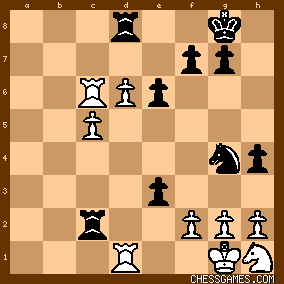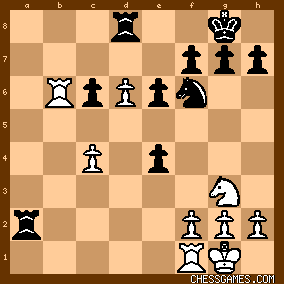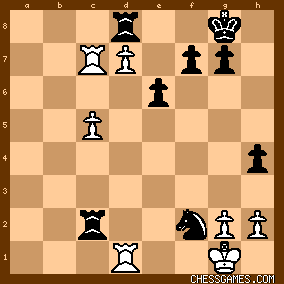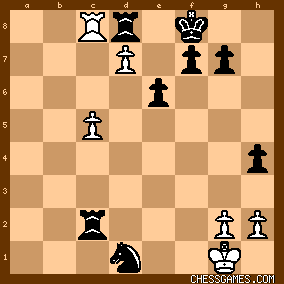|
< Earlier Kibitzing · PAGE 2 OF 2 ·
Later Kibitzing> |
| Jun-16-16 | | YouRang: The square getting the most attention is f2, and given its proxemity to white's K and the potential for mate threats, the only move crying to be made is <26...e3!>

click for larger view
I saw no good replies for white, e.g.
<27.fxe3> loses to <...Nxe3> forking the R and threatening ...Rxg2#. White's best appears to be 28.Nf2 Nxd1 29.Nxd1 Rc1, and black is up a rook  . . <27.Rf1> loses to <...e2 28.Re1> and the N takes a rook attacking tour, e.g. <28...Ne5 29.Rb6 Nd3> and black is up at least the exchange and a pawn  . . <27.Rc7> loses about the same way after <...e2 28.Re1 Ne5 etc.> <27.f3> loses about the same way <...e2 28.Re1 Ne5 etc.> <27.Rb6> (and most other moves) lose to <...exf2+! 28.Nxf2> (28.Kf1? Nxh2#) <28...Nxf2> and black is up a knight  . . |
|
| Jun-16-16 | | YouRang: <An Englishman: Good Evening: Solved it, but the interesting moment for me came after 22.Rb6. In my playing days I would have replied with ...Rc8 intending ...Nd7 and ...f7-f5, but Anand finds a much better idea, giving back the extra pawn (and allowing connected passed pawns!) in order to bury the White Knight at h1.> Good observation. The pitiful cornered knight contributed greatly to white's woes a few moves later. One wonders how far in advance was Anand able to see the whole 26...e3 scheme. At black's 22nd move:

click for larger view
I don't think I would have seen 22...h5! either. I might have opted for 22...c5 to keep the pawns from connecting, and then maybe ...h5 to create luft and annoy the Ng3. Beyond that is mostly fog. |
|
| Jun-16-16 | | Once: Interesting. Very interesting.
I was never much impressed by pawns when I was a kid. They didn't have the bludgeoning power of a rook or queen, or the weird hoppiness of a knight. They just trundle predictably down the board. True, they have some weird party pieces, like en passant and coronation. But apart from that, they are bread and butter. Booooring. And there's this weird thing that pawns do. They are the only pieces which move in one direction and capture in another. That's just odd. Until you see a position like today's. After the delicious 26...e3, we get to here: 
click for larger viewThe black pawn is threatening both exf2+ and e2. The thing that makes it odd (moving and capturing in different directions) actually gives it more options. Ah, but there's a kicker. Take a look at the mass of white pawns far advanced in the centre. They ought to be powerful and threateny, but they aren't. Black's one pawn on e3 is far more dangerous than white's two pawns on c5 and d6. Pawns can do mighty mighty things. But you've got to get them into the right situation to transform them from dull plodders to surprisingly interesting. Good puzzle. |
|
| Jun-16-16 | | AlicesKnight: 26..... e3 has a "look" about it; moves like 27.Kf1 or fxe obviously fail and if 27.d7 ignoring threats, then ....Rxd7. What about Re1? - either here or after something else? If 27.Re1 then exf+ wins a piece - is it enough to stop the WPs? - probably. What of 27.f3? The BN can't play to e3 for the mating threat, so ....e2 perhaps; 28.Rd1 and now the BN is under threat... must rush, so let's see - ah, missed the f-file counter-attack, but got some of it. Nice end resource, which he probably saw early. |
|
| Jun-16-16 | | Moszkowski012273: 27...e2 is definitely stronger. |
|
| Jun-16-16 | | Cheapo by the Dozen: The main question is whether White can shrug off Black's maneuvers and proceed with d7 and Rc8. The answer is that he can't, because the d1 rook has to move to e1 or f1 as part of the shrug. |
|
| Jun-16-16 | | TorontoNewf: <goldfarbdj>
27 f3 h3
And either
28 fxg4 Rxg2+, and e2 mates or
29 gxh Nxh2, followed by Nf3.
I don't see how white defends |
|
| Jun-16-16 | | 11thHeaven: Why doesn't 29. d7 win for white? |
|
Jun-16-16
 | | Sally Simpson: HI 11thHeaven,
Why doesn't 29. d7 win for white?

click for larger view29. d7 Rxd7
Look out for the back rank mate...mate. |
|
| Jun-16-16 | | Jim Bartle: I think you have the wrong position there. |
|
| Jun-16-16 | | pedro99: blitz schmitz |
|
| Jun-16-16 | | mel gibson: An easy one. |
|
| Jun-16-16 | | Virgil A: 26...e3 is wanpis. |
|
| Jun-16-16 | | Carlos0012358: Black has a considerable positional advantage, and no matter how well White plays from here there is no winning, unless Black commits a blunder.
That said, after the powerful 26....e3!, White could have done better than 27.Rc7. For example, 27.h3 might have been a better continuation, followed by
27....exf2+
28.Nxf2 Nxf2
Either way, eventually Black retain a N advantage and eventually mows down Whites army. |
|
| Jun-16-16 | | kevin86: The start was easy, but I couldn't figure the closing moves. |
|
| Jun-16-16 | | agb2002: The material is identical.
White threatens d7 and Rc8.
Black can attack the white king and rooks with 26... e3: A) 27.fxe3 Nxe3 28.Nf2 (due to 28... Rxg2#) 28... Nxd1 29.Nxd1 Rc1 wins a rook. B) 27.f3 e2
B.1) 28.Re1 Ne5 29.Rc7 Nd3 30.d7 Nxe1 31.Rc8 Nxf3+ 32.Kf2 (32.gxf3 e1=Q#) 32... e1=Q+ 33.Kxf3 Qd1+ followed by 34... Qd7 wins. B.2) 28.Ra(b)8 Rd2 29.Nf2 (29.fxg4 Rd1+ wins) 29... Nxf2 30.Kxf2 Rd1 wins. C) 27.Rf1 e2 28.Re1 Rd2 followed by 29... Rd1 wins.
D) 27.d7 Rxd7 28.Rcd7 (28.Rxd7 Rc1+ 29.Rd1 Rxd1#) 28... Rxd6 29.cxd6 e2 30.Re1 Rd2 wins (31.d7 Rxd7 32.Rxe2 Rd1+). E) 27.f3 e2 followed by Rd2 is similar to previous lines. |
|
| Jun-16-16 | | YouRang: <11thHeaven: Why doesn't 29. d7 win for white?> Good question. After 29.d7

click for larger view
Simply 29...Nxd1. If 30.Rc8 (pinning the Rd8, black wins with 30...Kf8!

click for larger view
Now 31.Rxd8+ Ke7, white has to move the rook, and the king eats the pawn and enjoys a big material advantage. White may have hopes of capturing enough black pawns to make a difficult endgame, but he doesn't have time. A likely continuation is 32.Rf8 Kxe7 33.Rxf7+ Kc6

click for larger view
If 34.Re7 Re2! (protects Pe6 and threatens Re1#) 35.Kf1 Nc3 36.Rxg7 e5! and white can't stop the pawn. If 34.Rxg7 e5! 35.Re7 Ne3! (now if 36.Rxe5 Rc1+ 37.Kf2 Ng4+ forking K+R). |
|
| Jun-16-16 | | stst: The only threatening move is e3, others will only wait for White pawn promotion, thus
26.........e3
then there's a short and a long ending:
(A)
27.fxe3 Nxe3 and there's no defense to f1 & g2 both under the shoe of the N@e3 at the same time (strike by R)(B) back-rank R defends at last resort:
27.Re1 e2
28.d7 (race) Rd2 (get close for exchange)
29.Rc8 (brute) Rd1 (race, return the color)
30.Rxd8+ Kh7
31.g3 (get breathing room) Rxe1+
32.Kg2 RxN
33.any e1=Q
and Black should prevail. |
|
| Jun-16-16 | | stst: The course in the game, in my opinion is, at least, not pretty.
Very surprised a Russian GM got his own mate by 30.Rff7, leaving the obvious Rc1#. |
|
| Jun-16-16 | | mworld: Rc1 is not mate after the forced Rf1 is played...so maybe not so obvious. |
|
| Jun-16-16 | | morfishine: I've seen this one <26...e3> |
|
| Jun-16-16 | | tonsillolith: Anand is a one-trick pony. He thinks a pawn on e3 will solve everything:
Kramnik vs Anand, 2008, etc. |
|
| Jun-16-16 | | YouRang: <mworld: Rc1 is not mate after the forced Rf1 is played...so maybe not so obvious.> True, but then black eats white's c & d pawns and remains up a N+P, which should be easily decisive. |
|
| Jun-16-16 | | King.Arthur.Brazil: I find the same movies for black, following white answers: (27.e3, 28.exf2+, 29.Nxf2, 30.Rc1+). But after: 30...Rf1 (forced), 31.Rxc5 then Rf-f7 (instead of Rxc5), 32.Rxc7 [if ... dxc7 33.Rd1+ Rf1 (forced) 34.Rxf1+ Kxf1 35.Nd6 and black win.] Rxc7 33.Rxd6! And black win a N and 2 P, this is: N+R x R final, which is not so easy to win. You must play carefully. |
|
| Jun-16-16 | | mworld: Yourang I believe that was the obvious conclusion that the "Russian" reached as well. |
|
 |
|
< Earlier Kibitzing · PAGE 2 OF 2 ·
Later Kibitzing> |





